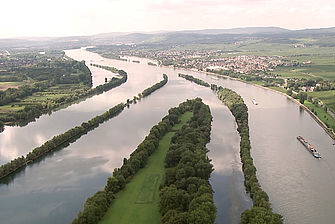Bachelor Degree Programs in this field
Master Degree Programs in this field
The master’s degree program UMSB (Environmental Management and Urban Planning in Metropolitan Areas) is unique in the German university landscape. It provides students with a professional and scientifically sound foundation, empowering them to solve the design challenges posed by settlement change, particularly in urban areas. The program is interdisciplinary: students combine environmental science and planning know-how from the areas of landscape architecture, civil engineering, urban development/urban planning and science, with knowledge and skills from the administrative sciences and management fields.
Overview of the wide range of topics covered in Bachelor's and Master's theses at the Department of Landscape Planning and Nature Conservation:
| 2022 | Feige, Yannick | Analysis of land cover changes and possible carbon dioxide removal strategies compatible with the Sustainable Development Goals - an example for a region in South Africa | M.Sc. landscape architecture |
| 2022 | Romero, Nadia Chaquea | Green roofs - types, effects and funding opportunities by municipalities | M.Sc. landscape architecture |
| 2022 | Schmehle, Patrick | Potential and structural analysis of rural areas for a future-oriented area development in the Upper Middle Rhine Valley | M.Sc. landscape architecture |
| 2022 | Kirschner, Lucie Charlotte | Streuobstwiesen in der Metropolregion Frankfurt/RheinMain - Analysis of fruit species and fruit varieties with regard to their resistance to climate change | B.Eng. Landscape Architecture |
| 2022 | Böttcher, Leon; Kesseler, Myriam | Agroforestry systems as multifunctional land use - types, biodiversity, ecosystem services and planning steps | B.Eng. Landscape Architecture |
| 2022 | Beelitz, Nora | Green infrastructure using the example of the city of Mainz - Idea guide to the concept of green infrastructure | B.Eng. Landscape Architecture |
| 2022 | Rehm, Sebastian | Long-term perspective eco-account - Really permanent or only temporary compensation? | B.Eng. Landscape Architecture |
| 2022 | Hensel, Dennis | Analysis of ecological functions of short rotation plantations and potentials for a sustainable funding instrument | B.Eng. Landscape Architecture |
| 2022 | Scheffer, Jobst | Natural water retention of forestry using the example of calamity areas in the Hochtaunus - An analysis and mapping of the course of surface water, for the upgrading of newly created open spaces in the Hochtaunus | B.Eng. Landscape Architecture |
| 2022 | Lessnow, Robyn | Effects of Climate Change on Forests: Climate Adaptation and Biodiversity Development in Central European Forests | B.Eng. Landscape Architecture |
| 2022 | Koch, Katharina | NATURE FOR ALL. Inclusive nature tourism offers and accessibility in protected areas | B.Eng. Landscape Architecture |
| 2022 | Fischer, Felix | Agri-Photovoltaics - Dual use of vineyards and their acceptance by the population | B.Eng. Landscape Architecture |
| 2022 | Engfeld, Helena | Entwicklung des Wissensstandes zum Zusammenhang zwischen Klimawandel und Biodiversität in Deutschland | M.Sc. Landschaftsarchitektur |
| 2022 | Hilfrich, Nadja | Nutzungsänderung urbaner Grünanlagen im Stadtgebiet Wiesbadens bedingt durch die COVID-19-Pandemie | B.Eng. Landschaftsarchitektur2022 |
| 2022 | Trautwein, Jasmin | Influence of seminatural habitats and landscape structures on bird diversity in Rheinhessen vineyards | M. Eng. Environmental Management and Urban Planning in Metropolitan Areas |
| 2021 | Eckes, Jenny | Einflüsse des Klimawandels auf den Wald und dessen Funktionen | B.Eng. Landschaftsarchitektur |
| 2021 | Bindewald, Ruth | Naturschutzberatung für landwirtschaftliche Betriebe auf Grundlage des High Nature Value Farmland- Indikators am Beispiel des Demeterhofs Breit | M.Sc. Landschaftsarchitektur |
| 2021 | Frings, Christian | Biodiversität aus Sicht deutscher Weinproduzenten: Eine qualitative Analyse in den Weinregionen Baden, Franken und Württemberg | B.Eng. Landschaftsarchitektur |
| 2021 | Ladentin, Lisa | Regionale Mostobstproduktion in Hessen – Beiträge von Mostobstflächen zur Biodiversität und zum Naturtourismus | M.Sc. Landschaftsarchitektur |
| 2021 | Staaden, Jessica | Auswertung der Agrarstrukturen und des Maßnahmeneinsatzes in Schwerpunkträumen für Leitarten der Agrarlandschaft in Hessen | M.Eng. Umweltmanagement und Stadtplanung in Ballungsräumen |
| 2020 | Cäsar, Hildegard | Potentialanalyse von Biodiversitätsmaßnahmen im ökologischen Produktionsgemüsebau | M.Sc. Gartenbauwissenschaften |
| 2020 | Gärtner, Jana | Modulare Begrünung – eine Chance für ästhetische und naturschutzfachliche Aufwertung im urbanen Raum | B.Eng. Landschaftsarchitektur |
| 2020 | Gerigk, Jana | Potentielle Auswirkungen künftiger klimatischer Veränderungen auf die Rotbuche | B.Eng. Landschaftsarchitektur |
| 2020 | Hirschmann, Caroline | Der Rheingau als Biosphärenregion – Potenziale, Chancen und Risiken für den Weinbau | B.Sc. Weinbau und Oenologie |
| 2020 | Panfil, Lasse | Möglichkeiten einer Einbindung von Mastfußflächen als Trittsteine in den Biotopverbund einer von Weinbau geprägten Landschaft | B.Eng. Landschaftsarchitektur |
| 2020 | Rothenbücher, Melvin | Umweltprobleme durch Stickstoff in der Landwirtschaft und Bewertung des aktuell gültigen Rechtsrahmens | B.Eng. Landschaftsarchitektur |
| 2020 | Schröder, Jan Niklas | Möglichkeiten der Effektivierung von Maßnahmen zur Produktionsintegrierten Kompensation (PIK) in der Landwirtschaft | B.Eng. Landschaftsarchitektur |
| 2020 | Staudt, Sabrina | Raumnutzungsverhalten von Exmoor-Ponys und Auswirkungen extensiver Pferde-Beweidung auf Uferstrukturen von Bächen | B.Eng. Landschaftsarchitektur |
| 2019 | Dornhoeffer, Alexander | Das Schutzgut Landschaft in der Umweltverträglichkeitsprüfung. Anspruch und Realität – eine Analyse | M.Sc. Landschaftsarchitektur |
| 2019 | Friedel, Lukas | Umsiedlung von Mauer- und Zauneidechsen als artenschutzrechtliche Konfliktvermeidung? Ein Vergleich der Praxis mit den theoretischen Grundlagen | B.Eng. Landschaftsarchitektur |
| 2019 | Habermann, Stephanie | Lichtverschmutzung. Nachhaltige Beleuchtung in der Bauleitplanung als wichtiges Instrument der Lichtoptimierung | B.Eng. Landschaftsarchitektur |
| 2019 | Henn, Christina | Aufgabe einer Biosphärenregion Taunus-Rhein-Main mit Focus auf die Freizeit- und Erholungsfunktion für die Bevölkerung sowie der Mobilität innerhalb der Region | M.Sc. Landschaftsarchitektur |
| 2019 | Jakob, Melanie | Gefährdung, Schutz und Entwicklung von Streuobstwiesen im Wetteraukreis | B.Eng. Landschaftsarchitektur |
| 2019 | Kraus, Jan | Entwicklung eines funktionalen Biotopverbundsystems für Bergheiden im Rothaargebirge als FFH-Lebensraumtyp | M.Sc. Landschaftsarchitektur |
| 2019 | Möller, Nelson | Umsetzungsdefizite von Kompensationsmaßnahmen in der Bauleitplanung – eine naturschutzfachliche Analyse der Umsetzungspraxis in Mittelhessen | B.Eng. Landschaftsarchitektur |
| 2019 | Neder, Jana | Entwicklung naturschutzfachlicher Begleitmaßnahmen bei der Anlage von Retentionsbecken im Wassereinzugsgebiet Abtsdorfer See | B.Eng. Landschaftsarchitektur |
| 2019 | Nied, Lukas | Renaturierung des Erlenbachs bei Kandel (Südpfalz) vor dem Hintergrund der angestrebten Ziele der EU-Wasserrahmenrichtlinie für Fließgewässer | B.Eng. Landschaftsarchitektur |
| 2019 | Sabuga-a, Yvonne | Vermittlung von Hintergründen zur Gewässerrenaturierung mit dem Ziel der Partizipation und Umweltbildung | B.Eng. Landschaftsarchitektur |
| 2018 | Axer, Tim | Untersuchung des Einsatzes von Großflächenmähern – Vergleich der theoretischen mit der realen Mähleistung vor dem Hintergrund der Prozessoptimierung von Arbeitsstrategien am Beispiel der Stadt Frankfurt am Main | Diplom Landschaftsarchitektur |
| 2018 | Biegerl, Carolin | Der Umgang mit Vogelarten in der Umweltprüfung – eine vergleichende Analyse von avifaunistischen Gutachten in Planungsverfahren von Windenergieanlagen | B.Eng. Landschaftsarchitektur |
| 2018 | Engfeld, Helena Luise | Vögel in Obstwiesen und Obstplantagen – Eine vergleichende Analyse als Grundlage für den Schutz der Biodiversität | B.Eng. Landschaftsarchitektur |
| 2018 | Feige, Yannick | Auswirkungen des Klimawandels auf Ökosystemleistungen in Weinbaugebieten des Rheingaus und Konsequenzen für die kommunale Landschaftsplanung | B.Eng. Landschaftsarchitektur |
| 2018 | Gehrs, Giulio | Potentiale zur naturnahen Gestaltung von Abschnitten des Oberrheins | B.Eng. Landschaftsarchitektur |
| 2018 | Goldmann, Jannette | Analyse und Management von landwirtschaftlich entstandenen kulturhistorischen Landschaftselementen – ein Konzept am Beispiel Börfinks im Nationalpark Hunsrück-Hochwald | M.Sc. Landschaftsarchitektur |
| 2018 | Ihme, Stephanie | Diasporentransport bei Pferden | Diplom Landschaftsarchitektur |
| 2018 | Pohlmann, Patrick | Grüne Infrastruktur im urbanen Raum: Ziele und Potentiale grüner Infrastruktur in einer Großstadt am Beispiel von Darmstadt | Umweltmanagement und Stadtplanung in Ballungsräumen |
| 2018 | Raab, Bastian | Reduzierung des Biodivsitätsverlustes in Agrarlandschaften | Diplom Landschaftsarchitektur |
| 2018 | Schuck, Patrick | Hunsrückwald begegnet Nahewein: Pflanz- und Pflegekonzept für öffentliche Grünflächen und Baumstandorte der Ortsgemeinde Waldböckelheim | B.Eng. Landschaftsarchitektur |
| 2018 | Schuler, Victoria | Wirkungen unterschiedlicher Weideregime auf die räumliche Strukturvielfalt der Vegetation auf einer Konversionsfläche in Aschaffenburg | B.Eng. Landschaftsarchitektur |
| 2018 | Simon, Elena | Der Biber als Ökosystemingenieur – Wie können seine Ausbreitung und Dienste in den Naturschutz integriert und Konflikte dabei vermieden werden? | B.Eng. Landschaftsarchitektur |
| 2017 | Blenk, Stephan | Entwicklung eines Pflege- und Nutzungskonzeptes für Heckenstrukturen am Beispiel des Wassergutes Canitz | B.Eng. Landschaftsarchitektur |
| 2017 | Hieronymi, Paula | Möglichkeiten zur Förderung der Biodiversität in Agrarlandschaften anhand der Begleitflora | B.Eng. Landschaftsarchitektur |
| 2017 | Jung, Maureen | Das Landschaftspflegemanagement in Baden-Württemberg und die Aufgabenwahrnehmung durch die Landschaftserhaltungsverbände anhand des Beispiels Ostalbkreis | B.Eng. Landschaftsarchitektur |
| 2017 | Leske, Natalie | Problematik von Lichtquellen und Lichtverschmutzung in urbanen Freiräumen und der freien Landschaft mit Lösungsvorschlägen anhand ausgewählter Beispiele | B.Eng. Landschaftsarchitektur |
| 2017 | Rothenburger, Lisa | Entwicklung eines 'Kommunikationskonzeptes Streuobst' für das Streuobstzentrum MainÄppelHaus Lohrberg e.V. Frankfurt am Main | B.Eng. Landschaftsarchitektur |
| 2017 | Weimann, Birgit | Managementkonzepte für Prozessschutzgebiete am Beispiel der zusammenhängenden Kernflächen des Wispertaunus | B.Eng. Landschaftsarchitektur |
| 2017 | Winkler, Janet | Systematik und Entwicklung der grünen Infrastruktur am Beispiel der Stadt Frankfurt am Main | B.Eng. Landschaftsarchitektur |














